A Method Validation for Simultaneous Determination of Phthalates and Bisphenol A Released from Plastic Water Containers
Abstract
Featured Application
Abstract
1. Introduction
2. Materials and Methods
2.1. Materials and Chemicals
2.2. Extraction Process Using Dispersive Liquid–Liquid Microextraction (DLLME) Methodology
2.3. GC-MS Analysis
3. Results and Discussion
3.1. Evaluation of the Extraction Process
3.2. Analytical Protocol Parameters
3.3. Real Sample Application
4. Conclusions
Author Contributions
Funding
Acknowledgments
Conflicts of Interest
References
- Dilkes-Hoffman, L.S.; Pratt, S.; Laycock, B.; Ashworth, P.; Lant, P.A. Public attitudes towards plastics. Resour. Conserv. Recycl. 2019, 147, 227–235. [Google Scholar] [CrossRef]
- Bauer, A.; Jesús, F.; Gómez Ramos, M.J.; Lozano, A.; Fernández-Alba, A.R. Identification of unexpected chemical contaminants in baby food coming from plastic packaging migration by high resolution accurate mass spectrometry. Food Chem. 2019, 295, 274–288. [Google Scholar] [CrossRef] [PubMed]
- García Ibarra, V.; de Quirós, A.; Paseiro Losada, P.; Sendón, R. Non-target analysis of intentionally and non intentionally added substances from plastic packaging materials and their migration into food simulants. Food Packag. Shelf Life 2019, 21, 100325. [Google Scholar] [CrossRef]
- Mohanty, A.K.; Vivekanandhan, S.; Pin, J.M.; Misra, M. Composites from renewable and sustainable resources: Challenges and innovations. Science 2018, 362, 536–542. [Google Scholar] [CrossRef] [PubMed]
- Groh, K.J.; Backhaus, T.; Carney-Almroth, B.; Geueke, B.; Inostroza, P.A.; Lennquist, A.; Leslie, H.A.; Maffini, M.; Slunge, D.; Trasande, L.; et al. Overview of known plastic packaging-associated chemicals and their hazards. Sci. Total Environ. 2019, 651, 3253–3268. [Google Scholar] [CrossRef] [PubMed]
- Luzi, F.; Torre, L.; Kenny, J.M.; Puglia, D. Bio-and fossil-based polymeric blends and nanocomposites for packaging: Structure-property relationship. Materials 2019, 12, 471. [Google Scholar] [CrossRef] [PubMed]
- Lorz, P.M.; Towae, F.K.; Enke, W.; Jäckh, R.; Bhargava, N.; Hillesheim, W. Phthalic Acid and Derivatives. In Ullmann’s Encyclopedia of Industrial Chemistry; Wiley-VCH: Weinheim, Germany, 2007. [Google Scholar] [CrossRef]
- Root, S.E.; Savagatrup, S.; Printz, A.D.; Rodriquez, D.; Lipomi, D.J. Mechanical properties of organic semiconductors for stretchable, highly flexible, and mechanically robust electronics. Chem. Rev. 2017, 117, 6467–6499. [Google Scholar] [CrossRef]
- Peters, E.N. Plastics, Information and Properties of Polymeric Materials. In Mechanical Engineers’ Handbook, 3rd ed.; Kutz, M., Ed.; Wiley: Hoboken, NJ, USA, 2005. [Google Scholar]
- Jamarani, R.; Erythropel, H.C.; Burkat, D.; Nicell, J.A.; Leask, R.L.; Maric, M. Rheology of green plasticizer/poly (vinyl chloride) blends via time-temperature superposition. Processes 2017, 5, 43. [Google Scholar] [CrossRef]
- Paluselli, V.; Galgani, F.; Sempéré, R. Phthalate release from plastic fragments and degradation in seawater. Environ. Sci. Technol. 2019, 53, 166–175. [Google Scholar] [CrossRef]
- Lili, M.; Wen, C.; Wentao, L.; Yufang, Z. The migration study in PVC food packaging film under microwave condition. In Proceedings of the 21st IAPRI World Conference Packaging, Zhuhai, China, 19–22 June 2018; pp. 744–750. [Google Scholar]
- Shu, H.; Jonsson, B.A.G.; Gennings, C.; Lindh, C.H.; Nanberg, E.; Borneagh, C.G. PVC flooring at home and uptake of phthalates in pregnant women. Indoor Air 2019, 29, 43–54. [Google Scholar] [CrossRef]
- Sopheak, N.; Sempere, R.; Delmont, A.; Paluselli, A.; Ouddane, B. Occurrence, fate, behavior and ecotoxicological state of phthalates in different environmental matrices. Environ. Sci. Technol. 2015, 49, 4019–4035. [Google Scholar]
- Savoca, D.; Arculeo, M.; Barreca, S.; Buscemi, S.; Caracappa, S.; Gentile, A.; Persichetti, M.F.; Pace, A. Chasing phthalates in tissues of marine turtles from the Mediterranean sea. Mar. Pollut. Bull. 2018, 127, 165–169. [Google Scholar] [CrossRef] [PubMed]
- Mikula, P.; Svobodovaá, Z.; Smutnaá, M. Phthalates: Toxicology and Food Safety—A Review. Czech J. Food Sci. 2005, 23, 217–223. [Google Scholar] [CrossRef]
- De Toni, L.; Tisato, F.; Seraglia, R.; Roverso, M.; Gandin, V.; Marzano, C.; Padrini, R.; Foresta, C. Phthalates and heavy metals as endocrine disruptors in food: A study on pre-packed coffee products. Toxicol. Rep. 2017, 4, 234–239. [Google Scholar] [CrossRef] [PubMed]
- EFSA (European Food Safety Authority); Gundert-Remy, U.; Bodin, J.; Bosetti, C.; FitzGerald, R.E.; Hanberg, A.; Hass, U.; Hooijmans, C.; Rooney, A.A.; Rousselle, C.; et al. Bisphenol A (BPA) Hazard Assessment Protocol; EFSA Supporting Publication: Parma, Italy, 2017. [CrossRef]
- Hauser, R.; Calafat, A.M. Phthalates and human health. Occup. Environ. Med. 2005, 62, 806–818. [Google Scholar] [CrossRef] [PubMed]
- Schettler, T. Human exposure to phthalates via consumer products. Int. J. Androl. 2006, 29, 134–139. [Google Scholar] [CrossRef]
- Latini, G. Monitoring phthalate exposure in humans. Clin. Chim. Acta 2005, 361, 20–29. [Google Scholar] [CrossRef]
- Shea, K.M. Pediatric exposure and potential toxicity of phthalate plasticizers. Pediatrics 2003, 111, 1467–1474. [Google Scholar] [CrossRef]
- Krais, A.M.; Andersen, C.; Eriksson, A.C.; Johnsson, E.; Nielsen, J.; Pagels, J.; Gudmundsson, A.; Lindh, C.H.; Wierzbicka, A. Excretion of urinary metabolites of the phthalate esters DEP and DEHP in 16 volunteers after inhalation and dermal exposure. Int. J. Environ. Res. Public Health 2018, 15, 2514. [Google Scholar] [CrossRef]
- Zeng, D.; Kang, Y.; Chen, J.; Li, A.; Chen, W.; Li, Z.; He, L.; Zhang, Q.; Luo, J.; Zeng, L. Dermal bioaccessibility of plasticizers in indoor dust and clothing. Sci. Total Environ. 2019, 672, 798–805. [Google Scholar] [CrossRef]
- Schmid, P.; Schlatter, C. Excretion and metabolism of di (2-ethylhexyl) phthalate in man. Xenobiotica 1985, 15, 251–256. [Google Scholar] [CrossRef] [PubMed]
- David, R.M. Exposure to phthalate esters. Environ. Health Perspect. 2000, 108, A440. [Google Scholar] [CrossRef] [PubMed]
- Xu, D.P.; Li, S.; Chen, Y.H.; Li, H.B.; Li, A.N.; Xu, X.R. Phthalates: Toxicity, occurrence and analytical methods. Int. J. Mod. Biol. Med. 2013, 4, 12–29. [Google Scholar]
- Nepalia, A.; Singh, A.; Mathur, N.; Kamath, R.; Pareek, S. Assessment of mutagenicity caused by popular baby foods and baby plastic-ware products: An imperative study using microbial bioassays and migration analysis. Ecotoxicol. Environ. Saf. 2018, 162, 391–399. [Google Scholar] [CrossRef] [PubMed]
- Chang, W.H.; Lee, C.C.; Yen, Y.H.; Chen, H.L. Oxidative damage in patients with benign prostatic hyperplasia and prostate cancer co-exposed to phthalates and to trace elements. Environ. Int. 2018, 121, 1179–1184. [Google Scholar] [CrossRef] [PubMed]
- Corton, J.C.; Cunningham, M.L.; Hummer, B.T.; Lau, C.; Meek, B.; Peters, J.M.; Popp, J.A.; Rhomberg, L.; Seed, J.; Klaunig, J.E. Mode of action framework analysis for receptor-mediated toxicity: The peroxisome proliferator-activated receptor alpha (PPARα) as a case study. Crit. Rev. Toxicol. 2014, 44, 1–49. [Google Scholar] [CrossRef] [PubMed]
- EFSA; Silano, V.; Baviera, J.M.B.; Bolognesi, C.; Bruüschweiler, B.J.; Chesson, A.; Cocconcelli, P.S.; Crebelli, R.; Gott, D.M.; Grobar, K.; et al. Draft Update of the Risk Assessment of di-Butylphthalate (DBP), Butyl-Benzyl-Phthalate (BBP), Bis (2-ethylhexyl) Phthalate (DEHP), Di-Isononylphthalate (DINP) and Di-Isodecylphthalate (DIDP) for Use in Food Contact Materials. Available online: https://www.efsa.europa.eu/sites/default/files/consultation/consultation/Phthalates_in_plastic_FCM_draft_opinion_for_public_consultation.pdf (accessed on 15 May 2019).
- Sarigiannis, D.A.; Karakitsios, S.P.; Handakas, E.; Simou, K.; Solomou, E.; Gotti, A. Integrated exposure and risk characterization of bisphenol-A in Europe. Food Chem. Toxicol. 2016, 98, 134–147. [Google Scholar] [CrossRef]
- Corrales, J.; Kristofco, L.A.; Steele, W.B.; Yates, B.S.; Breed, C.S.; Williams, E.S.; Brooks, B.W. Global assessment of Bisphenol A in the environment. Review and analysis of its occurrence and bioaccumulation. Dose Response 2015, 13, 1559325815598308. [Google Scholar] [CrossRef]
- Paut, J.; Desphande, S. Acute toxicity of bisphenol A to rats. Indian J. Exp. Biol. 2012, 50, 425–429. [Google Scholar]
- Vogel, S. The Politics of plastics: The making and unmaking of bisphenol a “safety”. Am. J. Public Health 2009, 99, S559–S566. [Google Scholar] [CrossRef]
- Markey, C.; Coombds, M.; Sonnenschein, C.; Soto, A. Mammalian development in a changing environment: Exposure to endocrine disruptors reveals the developmental plasticity of steroid-hormone target organs. Evol. Dev. 2003, 5, 1–9. [Google Scholar] [CrossRef]
- Vandenberg, L.; Chahoud, I.; Heindel, J.; Padmanabhan, V.P.F.; Schoenfelder, G. Urinary, circulating, and tissue biomonitoring studies indicate widespreadexposure to bisphenol A. Cienc. Saude Colet. 2012, 17, 407–434. [Google Scholar] [CrossRef]
- Richter, C.; Birnbaum, L.; Farabollini, F.; Newbold, R.; Rubin, B.; Talsness, C.; Saal, F. In vivo effects of bisphenol A in laboratory rodent studies. Reprod. Toxicol. 2007, 24, 199–224. [Google Scholar] [CrossRef] [PubMed]
- Ryan, K.K.; Haller, A.M.; Sorrell, J.E.; Woods, S.C.; Jandacek, R.J.; Seeley, R.J. Perinatal exposure to bisphenol-A and the development of metabolic syndrome in CD-1 mice. Endocrinology 2010, 151, 2603–2612. [Google Scholar] [CrossRef] [PubMed]
- Acevedo, N.; Davis, B.; Schaeberle, C.M.; Sonnenschein, C.; Soto, A.M. Perinatally administered bisphenol A as a potential mammary gland carcinogen in rats. Environ. Health Perspect. 2013, 121, 1040–1046. [Google Scholar] [CrossRef] [PubMed]
- Saal, F.; Nagel, S.; Coe, B.; Angle, B.; Taylor, J. The estrogenicendocrine disrupting chemical bisphenol A (BP-A) and obesity. Mol. Cell. Endocrinol. 2012, 354, 74–84. [Google Scholar] [CrossRef]
- Li, D.-K.; Miao, M.; Zhou, Z.J.; Wu, C.; Shi, H.; Liu, X.; Wang, S.; Yuan, W. Urine bisphenol-A level in relation to obesity and overweight in school-age children. PLoS ONE 2013, 8, e65399. [Google Scholar] [CrossRef] [PubMed]
- Coltro, L.; Pitta, J.B.; da Costa, P.A.; Favaro Perez, M.A.; de Araújo, V.A.; Rodrigues, R. Migration of conventional and new plasticizers from PVC films into food simulants: A comparative study. Food Control 2014, 44, 118–129. [Google Scholar] [CrossRef]
- Lambertini, F.; Catellani, D.; Vindigni, M.; Suman, M. Multiresidual LC-MS analysis of plasticizers used in PVC gaskets of lids and assessment of their migration into food sauces. J. Mass Spectrom. 2016, 51, 805–813. [Google Scholar] [CrossRef]
- Mercogliano, R.; Santonicola, S. Investigation on bisphenol A levels in human milk and dairy supply chain: A review. Food Chem. Toxicol. 2018, 114, 98–107. [Google Scholar] [CrossRef]
- Cortina-Puig, M.; Hurtado-Fernandez, E.; Lacorte, S. Plasticizers in drinking water and beverages. Curr. Anal. Chem. 2018, 14, 344–357. [Google Scholar] [CrossRef]
- Gallart-Ayala, H.; Núñez, O.; Lucci, P. Recent advances in LC-MS analysis of food-packaging contaminants. TrAC Trends Anal. Chem. 2013, 42, 186–204. [Google Scholar] [CrossRef]
- Kawamura, Y.; Tagai, C.; Maehara, T.; Yamada, T. Simultaneous determination method of additives in polyvinyl chloride. J. Food Hyg. Soc. Jpn. 1999, 40, 189–197. [Google Scholar] [CrossRef]
- Ozaki, A.; Yamaguchi, Y.; Okamoto, A.; Kawai, N. Determination of alkylphenols, bisphenol A, benzophenone and phthalates in containers of baby food, and migration into food simulants. J. Food Hyg. Soc. Jpn. 2002, 43, 260–266. [Google Scholar] [CrossRef][Green Version]
- Mitani, K.; Narimatsu, S.; Izushi, F.; Kataoka, H. Simple and rapid analysis of endocrine disruptors in liquid medicines and intravenous injection solutions by automated in-tube solid-phase microextraction/high performance liquid chromatography. J. Pharmaceut. Biomed. 2003, 32, 469–478. [Google Scholar] [CrossRef]
- Khedr, A. Optimized extraction method for LC-MS determination of bisphenol A, melamine and di (2-ethylhexyl) phthalate in selected soft drinks, syringes, and milk powder. J. Chromatogr. B 2013, 930, 98–103. [Google Scholar] [CrossRef] [PubMed]
- Dévier, M.H.; Le Menach, K.; Viglino, L.; Di Gioia, L.; Lachassagne, P.; Budzinski, H. Ultra-trace analysis of hormones, pharmaceutical substances, alkylphenols and phthalates in two French natural mineral waters. Sci. Total Environ. 2013, 443, 621–632. [Google Scholar] [CrossRef]
- Lo Turco, V.; Di Bella, G.; Potortiì, A.G.; Tropea, A.; Casale, E.K.; Fede, M.R.; Dugo, G. Determination of plasticisers and BPA in Sicilian and Calabrian nectar honeys by selected ion monitoring GC/MS. Food Addit. Contam. A 2016, 33, 1693–1699. [Google Scholar] [CrossRef]
- Myridakis, A.; Chalkiadaki, G.; Fotou, M.; Kogevinas, M.; Chatzi, L.; Stephanou, E.G. Exposure of preschool-age greek children (RHEA cohort) to bisphenol a, parabens, phthalates, and organophosphates. Environ. Sci. Technol. 2016, 50, 932–941. [Google Scholar] [CrossRef]
- Russo, M.V.; Notardonato, I.; Cinelli, G.; Avino, P. Evaluation of an analytical method for determining phthalate esters in wine samples by solid-phase extraction and gas chromatography coupled with ion-trap mass spectrometer detector. Anal. Bioanal. Chem. 2011, 402, 1373–1381. [Google Scholar] [CrossRef]
- Russo, M.V.; Avino, P.; Cinelli, G.; Notardonato, I. Sampling of organophosphorus pesticides at trace levels in the atmosphere using XAD-2 adsorbent and analysis by gas chromatography coupled with nitrogen-phosphorus and ion-trap mass spectrometry detectors. Anal. Bioanal. Chem. 2012, 404, 1517–1527. [Google Scholar] [CrossRef] [PubMed]
- Cinelli, G.; Avino, P.; Notardonato, I.; Centola, A.; Russo, M.V. Rapid analysis of six phthalate ester in wine by ultrasound-vortex-assisted dispersive liquid-liquid micro-extraction coupled with gas chromatography-flame ionization detector or gas chromatography-ion trap mass spectrometry. Anal. Chim. Acta 2013, 769, 72–78. [Google Scholar] [CrossRef] [PubMed]
- Cinelli, G.; Avino, P.; Notardonato, I.; Centola, A.; Russo, M.V. Study of XAD-2 adsorbent for the enrichment of trace levels of phthalate esters in hydroalcoholic food beverages and analysis by gas chromatography coupled with flame ionization and ion-trap mass spectrometry detectors. Food Chem. 2014, 146, 181–187. [Google Scholar] [CrossRef] [PubMed]
- Notardonato, I.; Avino, P.; Centola, A.; Cinelli, G.; Russo, M.V. Validation of a novel derivatization method for GC-ECD determination of acrylamide in food. Anal. Bioanal. Chem. 2013, 405, 6137–6141. [Google Scholar] [CrossRef] [PubMed]
- Notardonato, I.; Avino, P.; Cinelli, G.; Russo, M.V. Fast determination of phthalate ester residues in soft drinks and light alcoholic beverages by ultrasound/vortex assisted dispersive liquid-liquid microextraction followed by gas chromatography-ion trap mass spectrometry. RSC Adv. 2014, 4, 59655–59663. [Google Scholar]
- Russo, M.V.; Notardonato, I.; Avino, P.; Cinelli, G. Determination of phthalate esters at trace levels in light alcoholic drinks and soft drinks by XAD-2 adsorbent and gas chromatography coupled with ion trap-mass spectrometry detection. Anal. Methods 2014, 6, 7030–7037. [Google Scholar] [CrossRef]
- Russo, M.V.; Avino, P.; Perugini, L.; Notardonato, I. Extraction and GC-MS analysis of phthlate esters in food matrices: A review. RSC Adv. 2015, 5, 37023–37043. [Google Scholar] [CrossRef]
- Russo, M.V.; Avino, P.; Notardonato, I. Fast analysis of phthalates in freeze-dried baby foods by ultrasound-vortex-assisted liquid-liquid microextraction coupled with gas chromatography-ion trap/mass spectrometry. J. Chromatogr. A 2016, 1474, 1–7. [Google Scholar] [CrossRef]
- Sjöberg, P.J.R.; Markides, K.E. Capillary column supercritical fluid chromatography-atmospheric pressure ionisation mass spectrometry. Interface performance of atmospheric pressure chemical ionisation and electrospray ionization. J. Chromatogr. A 1999, 855, 317–327. [Google Scholar] [CrossRef]
- Lee, S.; Ryu, H.; Nam, K. Phenanthrene metabolites bound to soil organic matter by birnessite following partial biodegradation. Environ. Toxicol. Chem. 2009, 28, 946–952. [Google Scholar] [CrossRef]
- Chebbi, A.; Hentati, D.; Zaghden, H.; Baccar, N.; Rezgui, F.; Chalbi, M.; Sayadi, S.; Chamkha, M. Polycyclic aromatic hydrocarbon degradation and biosurfactant production by a newly isolated Pseudomonas sp. strain from used motor oil-contaminated soil. Int. Biodeterior. Biodegrad. 2017, 122, 128–140. [Google Scholar] [CrossRef]
- Russo, M.V.; Avino, P.; Perugini, L.; Notardonato, I. Fast analysis of nine PAHs in beer by ultrasound-vortex-assisted dispersive liquid-liquid micro-extraction coupled with gas chromatography-ion trap mass spectrometry. RSC Adv. 2016, 6, 13920–13927. [Google Scholar] [CrossRef]
- Avino, P.; Notardonato, I.; Perugini, L.; Russo, M.V. New protocol based on high-volume sampling followed by DLLME-GC-IT/MS for determining PAHs at ultra-trace levels in surface water samples. Microchem. J. 2017, 133, 251–257. [Google Scholar] [CrossRef]
- Knoll, J.K. Estimation of the limit of detection in chromatography. J. Chromatogr. Sci. 1985, 3, 422–425. [Google Scholar] [CrossRef]
- US Environmental Protection Agency. National Primary Drinking Water Regulations; Fed. Reg. Part 14, 40 CFR Part 141; USEPA: Washington, DC, USA, 1991; p. 395.
- Souza, R.R.; Martins, E.A.J.; Otomo, J.J.; Furusawa, H.A.; Pires, M.A.F. Determination of plasticizers in drinking water using gas chromatography and mass spectrometry. Quim. Nova 2012, 35, 1453–1458. [Google Scholar] [CrossRef]
- Gu, Y.Y.; Yu, X.J.; Peng, J.F.; Chen, S.B.; Zhong, Y.Y.; Yin, D.Q.; Hu, X.L. Simultaneous solid phase extraction coupled with liquid chromatography tandem mass spectrometry and gas chromatography tandem mass spectrometry for the highly sensitive determination of 15 endocrine disrupting chemicals in seafood. J. Chromatogr. B 2014, 965, 164–172. [Google Scholar] [CrossRef]
- Vidal, R.B.P.; Ibanñez, G.A.; Escandar, G.M. A green method for the quantification of plastics-derived endocrine disruptors in beverages by chemometrics- assisted liquid chromatography with simultaneous diode array and fluorescent detection. Talanta 2016, 159, 336–343. [Google Scholar] [CrossRef]
- Jiao, A.; Chen, H.W.; Zhang, S.L. A novel extraction-cleanup method for determination of trace PPCPs in water samples. Adv. Mater. Res. 2014, 1035, 173–179. [Google Scholar] [CrossRef]
- Gosetti, F.; Bolfi, B.; Robotti, E.; Manfredi, M.; Binotti, M.; Ferrero, F.; Bona, G.; Marengo, E. Study of endocrine disrupting compound release from different medical devices through an on-line SPE UHPLC-MS/MS method. Anal. Chim. Acta 2018, 1042, 141–154. [Google Scholar] [CrossRef]
- García-Córcoles, M.T.; Cipa, M.; Rodríguez-Gómez, R.; Rivas, A.; Olea-Serrano, F.; Vílchez, J.L.; Zafra-Gómez, A. Determination of bisphenols with estrogenic activity in plastic packaged baby food samples using solid-liquid extraction and clean-up with dispersive sorbents followed by gas chromatography tandem mass spectrometry analysis. Talanta 2018, 178, 441–448. [Google Scholar] [CrossRef]
- Gorji, S.; Biparva, P.; Bahram, M.; Nematzadeh, G. Development of magnetic solid phase microextraction method for determination of the endocrine disrupting chemicals leached from reused plastic bottles. Talanta 2019, 194, 859–869. [Google Scholar] [CrossRef] [PubMed]
- Tang, Z.; Han, Q.; Xie, L.; Chu, L.; Wang, Y.; Sun, Y.; Kang, X. Simultaneous determination of five phthalate esters and bisphenol A in milk by packed-nanofiber solid-phase extraction coupled with gas chromatography and mass spectrometry. J. Sep. Sci. 2019, 42, 851–861. [Google Scholar] [CrossRef] [PubMed]
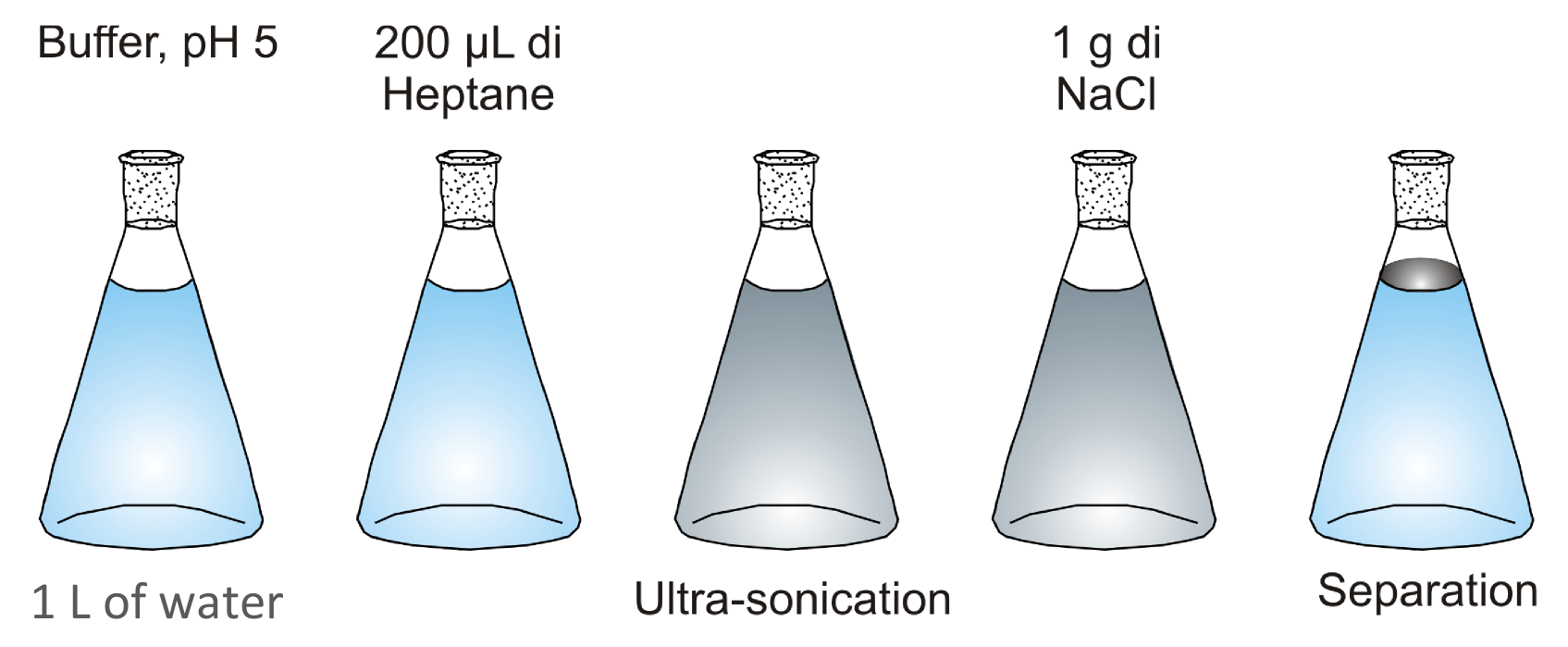
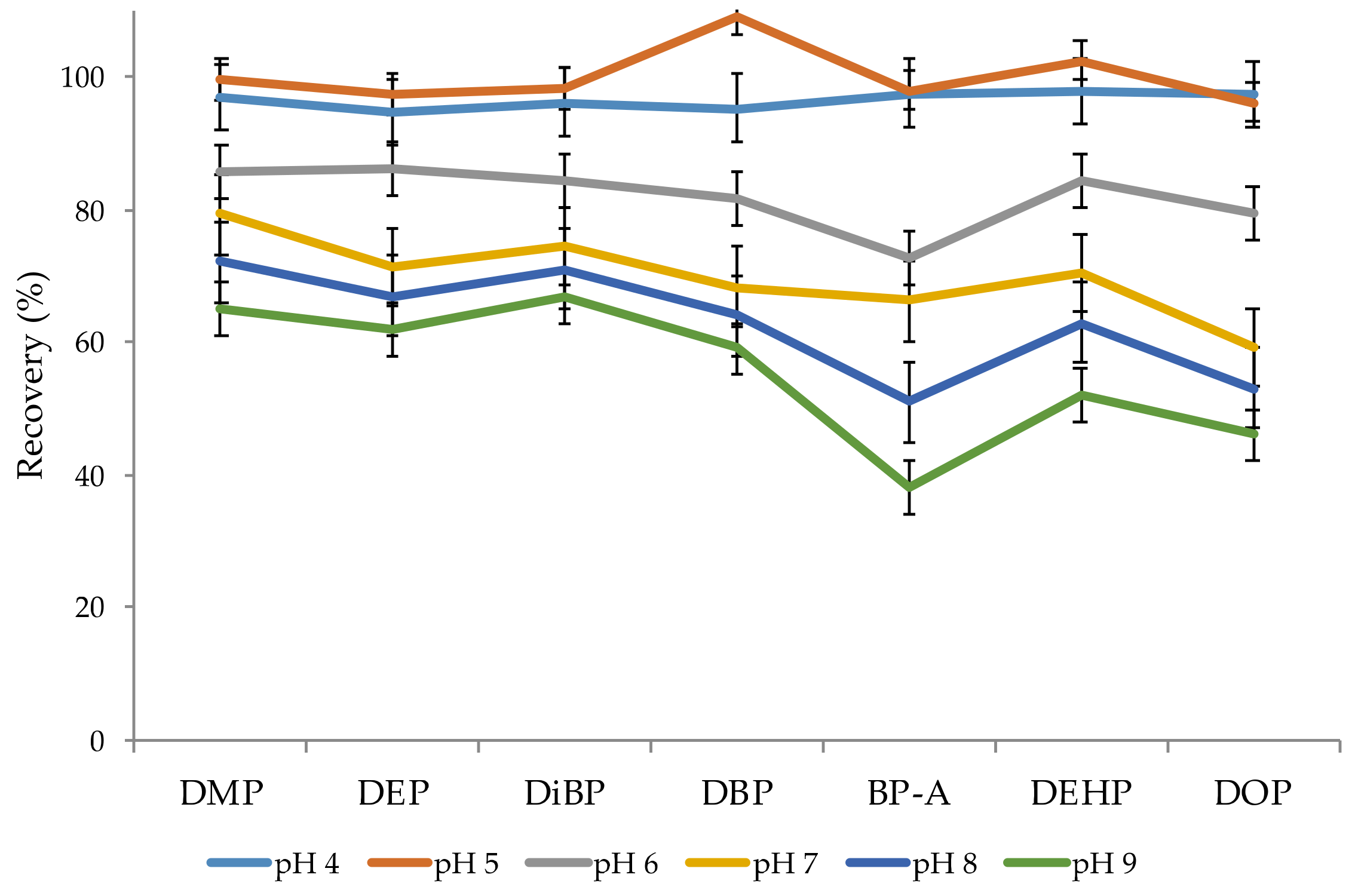
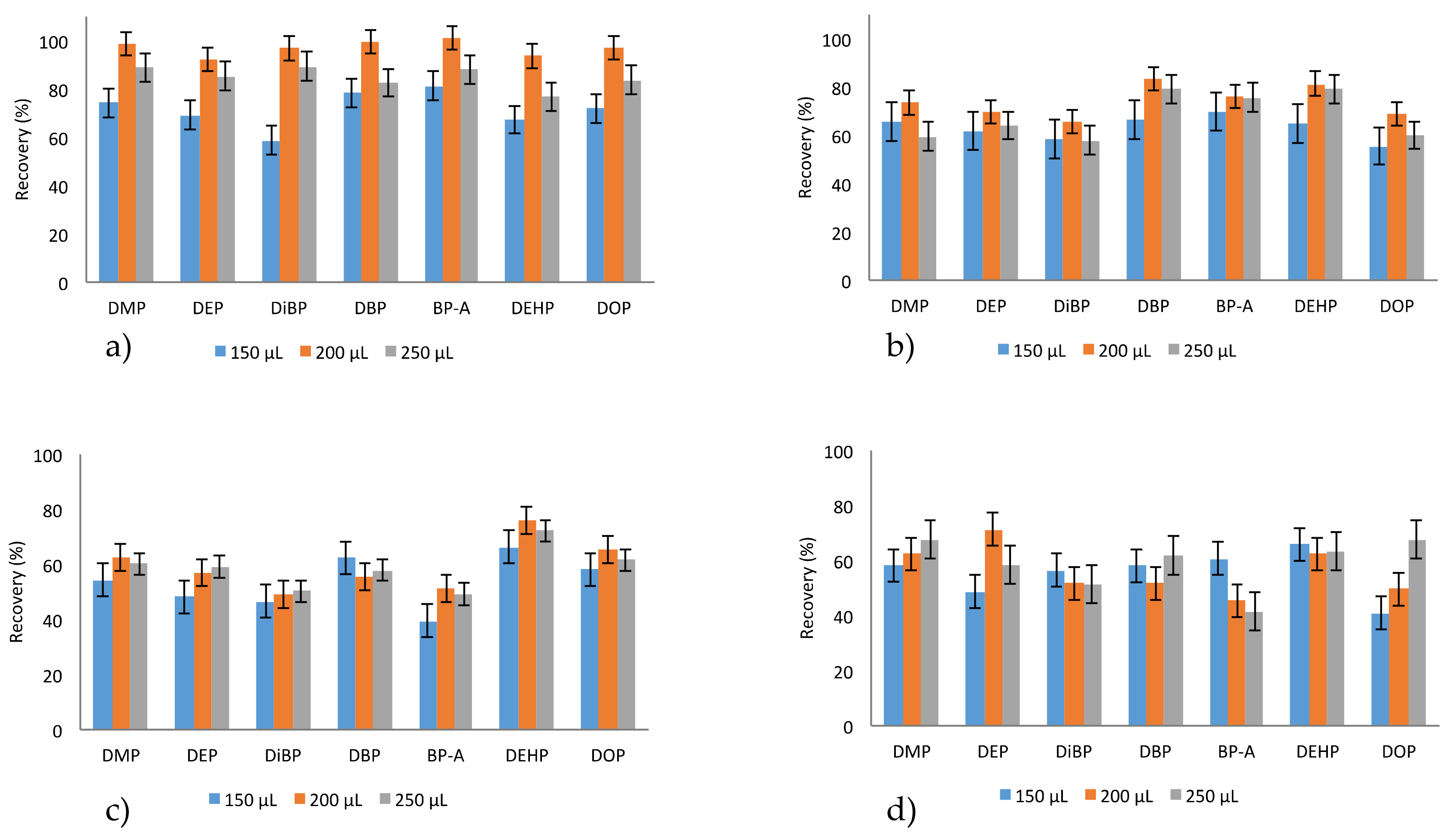

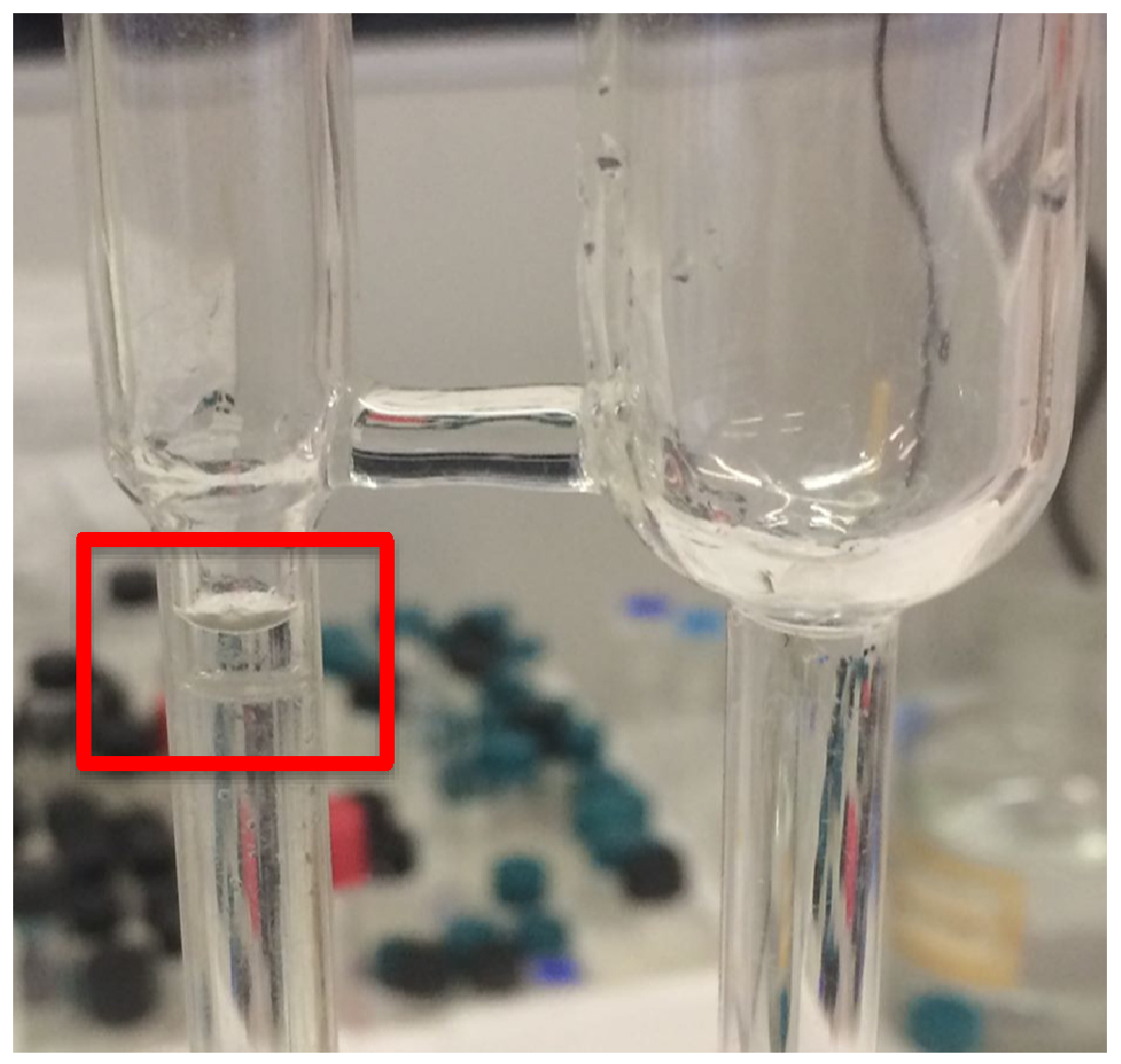
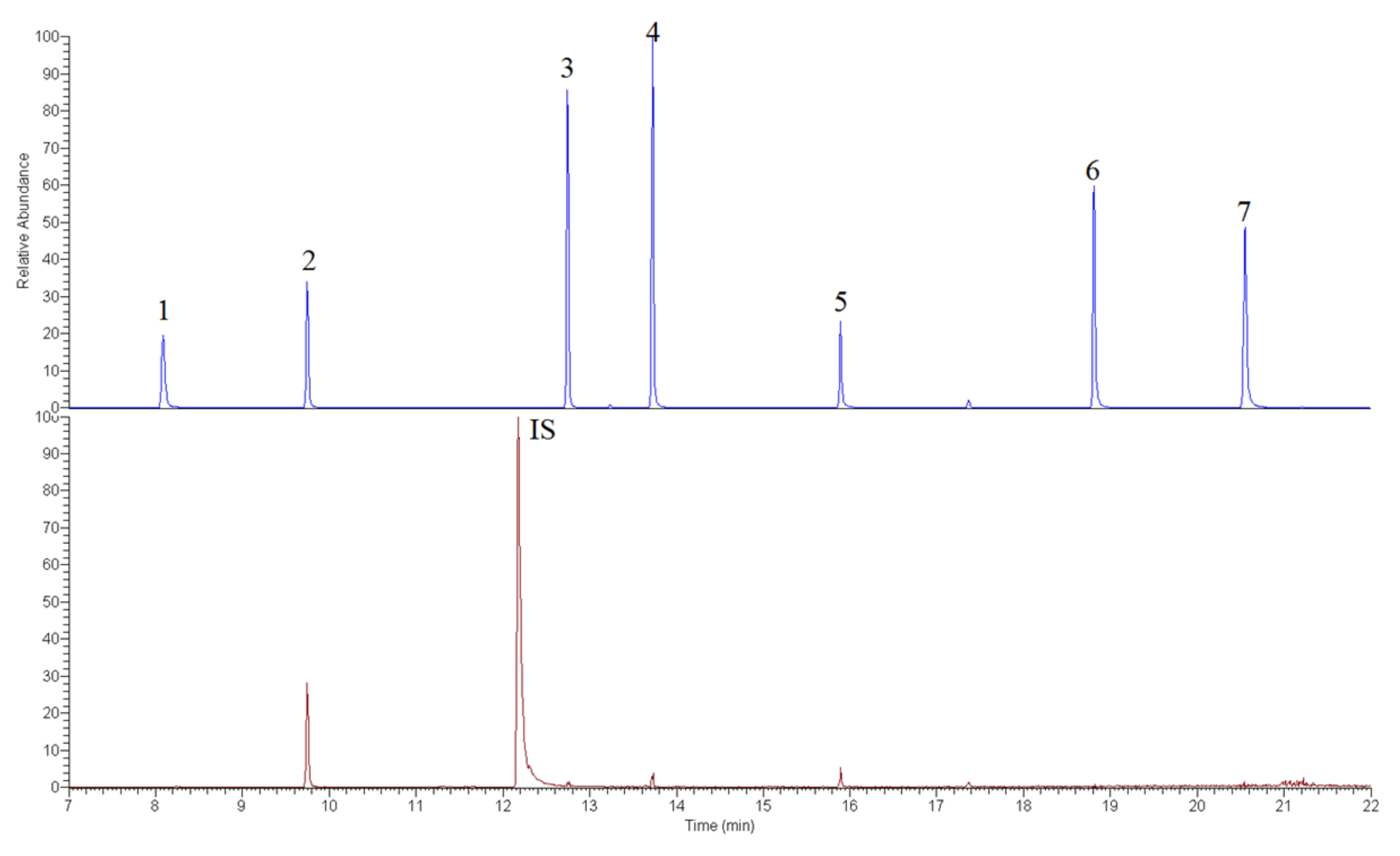
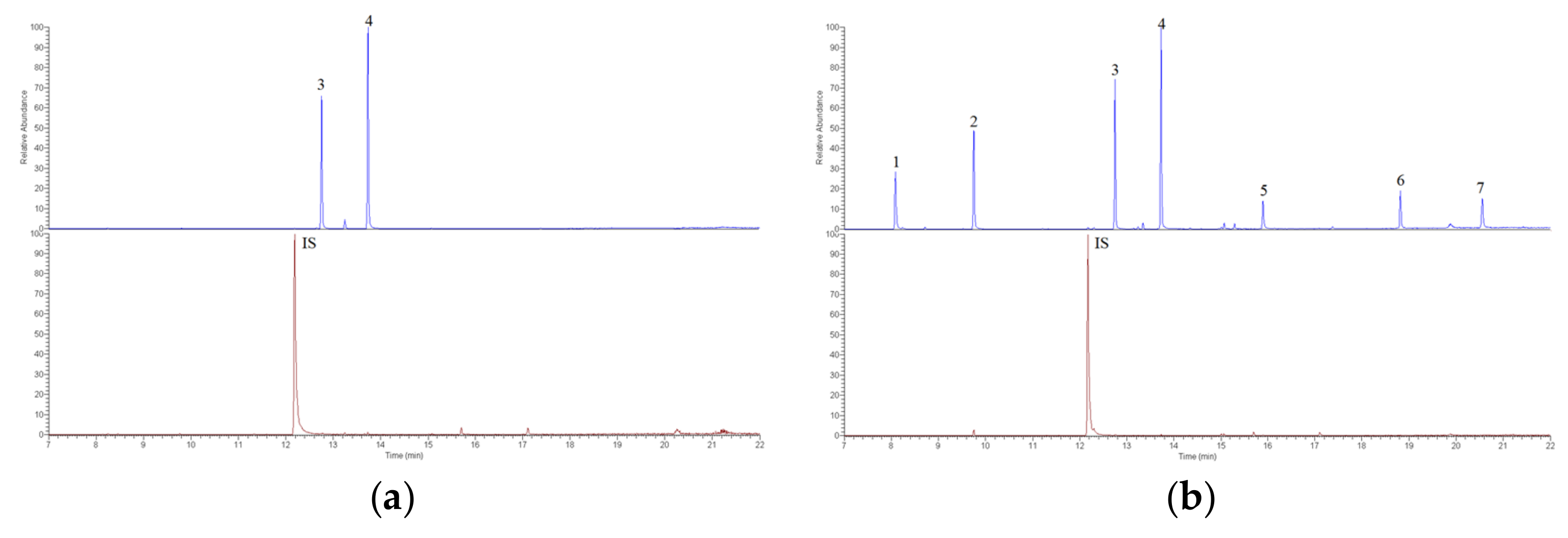

| Compound | Blank Solution | Real Sample |
|---|---|---|
| % ± SD (RSD) | % ± SD (RSD) | |
| DMP | 99.1 ± 2.1 (2.1) | 97.5 ± 3.5 (3.6) |
| DEP | 99.6 ± 1.6 (1.6) | 97.9 ± 5.9 (6.0) |
| DiBP | 98.5 ± 3.1 (3.1) | 98.8 ± 8.6 (8.7) |
| DBP | 99.1 ± 3.5 (3.5) | 98.4 ± 3.8 (3.9) |
| BPA | 97.2 ± 4.3 (4.4) | 95.1 ± 6.2 (6.5) |
| DEHP | 97.9 ± 2.6 (2.4) | 96.3 ± 5.2 (5.4) |
| DOP | 99.7 ± 1.7 (1.7) | 98.2 ± 4.1 (4.2) |
| Compound | LDR (ng mL−1) | Correlation Curve | r | LOD (ng mL−1) | LOQ (ng mL−1) | Limit |
|---|---|---|---|---|---|---|
| DMP | 6–1500 | y = 2.860x + 0.516 | 0.9944 | 1 | 6 | 5.0a |
| DEP | 11–1500 | y = 1.810x + 0.130 | 0.9983 | 4 | 11 | 0.55a |
| DiBP | 6–1500 | y = 1.984x + 0.227 | 0.9933 | 3 | 6 | 0.01b |
| DBP | 5–1500 | y = 2.493x + 0.212 | 0.9981 | 2 | 5 | 0.45a |
| BPA | 9–1500 | y = 2.102x + 0.295 | 0.9961 | 5 | 9 | 50c |
| DEHP | 9–1500 | y = 2.392x + 0.258 | 0.9972 | 1 | 9 | 8d |
| DOP | 14–1500 | y = 2.014x + 0.253 | 0.9979 | 8 | 14 |
| Compound | Recovery | Intra-day | Inter-day | |
|---|---|---|---|---|
| 30 ng mL−1 | 300 ng mL−1 | (RSD, %) | (RSD, %) | |
| DMP | 96.5 | 98.3 | 4.2 | 7.9 |
| DEP | 99.1 | 95.7 | 5.4 | 7.3 |
| DiBP | 101.1 | 103.7 | 5.7 | 8.2 |
| DBP | 97.5 | 101.2 | 4.5 | 6.1 |
| BPA | 93.4 | 95.8 | 7.4 | 9.3 |
| DEHP | 98.1 | 104.5 | 3.6 | 5.1 |
| DOP | 99.4 | 102.6 | 4.1 | 6.7 |
| Compounds | Matrix | Recoveries (%) | LODs/LOQs (ng mL−1) | References |
|---|---|---|---|---|
| DEP, DBP, BPA | drinking water | 62–105 | 7–29/23–44a | [71] |
| DEHP, –BPA | soft drinks, milk powder | 83.0–102.5 | 13–21/46–66b | [51] |
| DEP, DMP, DBP, BBP, –BPA, DEHP, DOP | French mineral waters | 90–110 | 0.1–1.6/10–30b | [52] |
| DMP, DEP, DBP, –BPA, DEHP | seafood | 57–119 | 0.034/0.64/-c | [72] |
| DEP, DBP, DEHP, BPA | mineral water, juice, soft drinks, wine, beer, distilled beverages | 90–100 | 0.04–0.38/- | [73] |
| DMP, DEP, DEP, DBP, BPA, BBP, DEHP, DOP | honey | 81.2–119.8 | 5–303/3–270 | [53] |
| DEP, DBP, DEHP, BPA | environmental water | 75.3–84.3 | 2.0–8.5/6.6–28.0 | [74] |
| BPA, BP-S, DBP, DEHP, DEP | medical devices | 95.7–109 | 0.8–15.5/2.3–46.9b | [75] |
| BPAF, BPA, BPB, BPS, BPP | ready-to-eat plastic packaged baby foods | 91–106 | 0.1–1/0.5–4c | [76] |
| DMP, DEP, DiBP, DBP, DEHP | water and liquid food from reused plastic bottles | 87.4–106.9 | 0.008–1/0.026–3.26 | [77] |
| DEP, DBP, BPA, BBP, DEHP | fruit juice | 81.9–109.6 | 20–300/60–1100 | [78] |
| DMP, DEP, DiBP, DBP, BPA, DEHP, DOP | mineral water, tap water | 93.4–104.5 | 1–8/6–14 | This study |
© 2019 by the authors. Licensee MDPI, Basel, Switzerland. This article is an open access article distributed under the terms and conditions of the Creative Commons Attribution (CC BY) license (http://creativecommons.org/licenses/by/4.0/).
Share and Cite
Notardonato, I.; Protano, C.; Vitali, M.; Bhattacharya, B.; Avino, P. A Method Validation for Simultaneous Determination of Phthalates and Bisphenol A Released from Plastic Water Containers. Appl. Sci. 2019, 9, 2945. https://doi.org/10.3390/app9142945
Notardonato I, Protano C, Vitali M, Bhattacharya B, Avino P. A Method Validation for Simultaneous Determination of Phthalates and Bisphenol A Released from Plastic Water Containers. Applied Sciences. 2019; 9(14):2945. https://doi.org/10.3390/app9142945
Chicago/Turabian StyleNotardonato, Ivan, Carmela Protano, Matteo Vitali, Badal Bhattacharya, and Pasquale Avino. 2019. "A Method Validation for Simultaneous Determination of Phthalates and Bisphenol A Released from Plastic Water Containers" Applied Sciences 9, no. 14: 2945. https://doi.org/10.3390/app9142945
APA StyleNotardonato, I., Protano, C., Vitali, M., Bhattacharya, B., & Avino, P. (2019). A Method Validation for Simultaneous Determination of Phthalates and Bisphenol A Released from Plastic Water Containers. Applied Sciences, 9(14), 2945. https://doi.org/10.3390/app9142945








